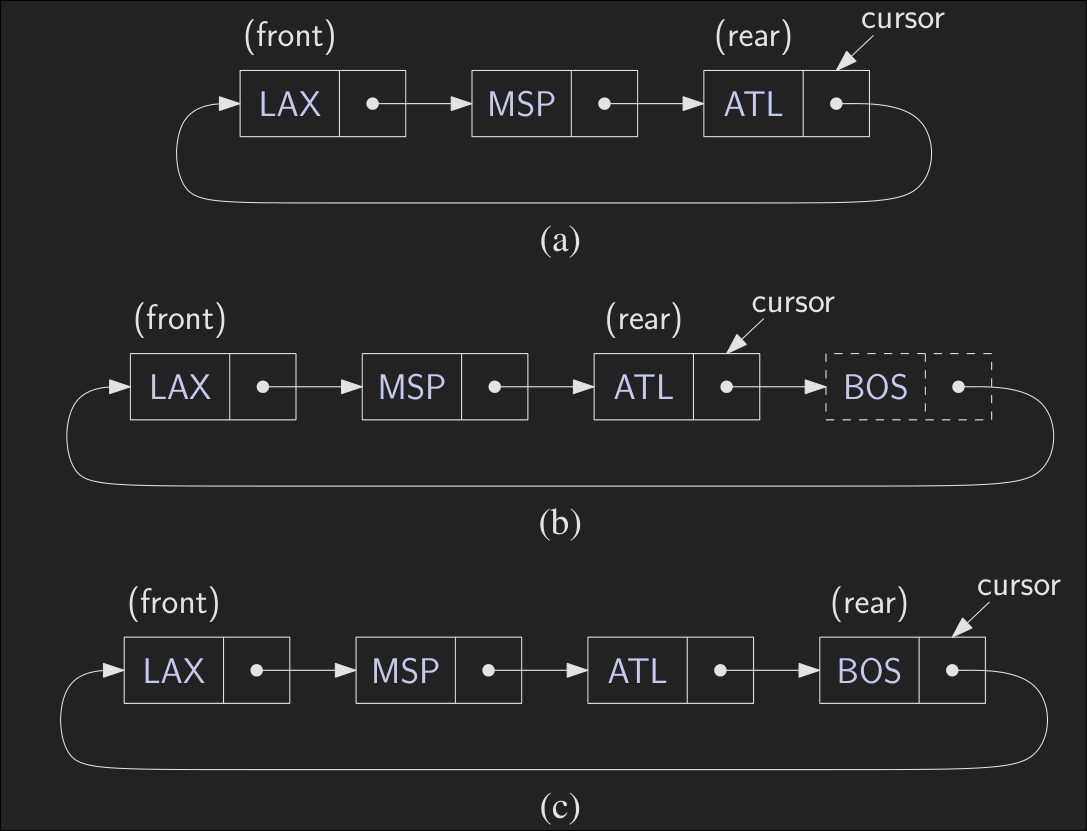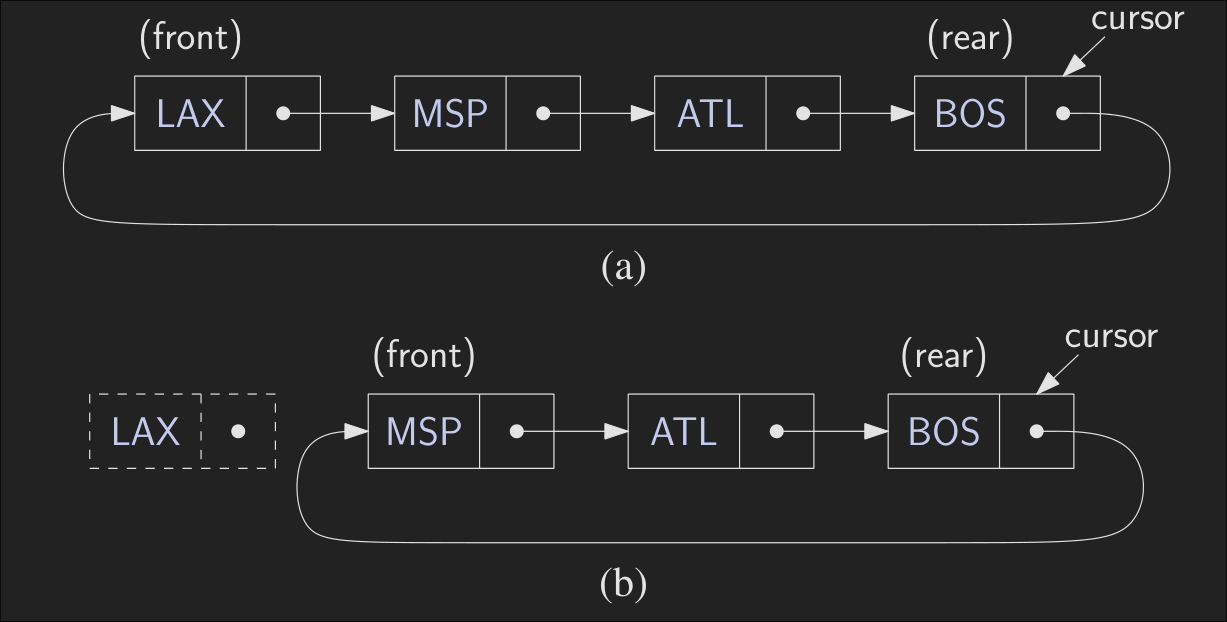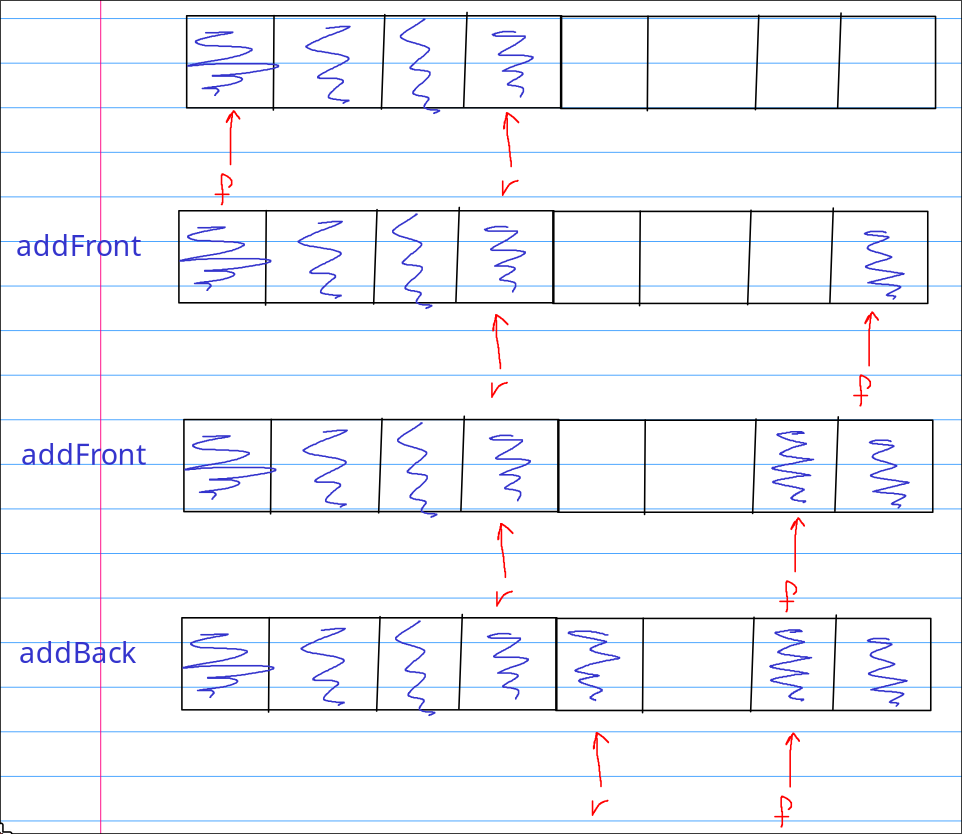Queue
Queue is a simple data structure serves collection of elements with 2 main operations (enqueue and dequeue). The order of each element is added or removed from a stack is referred by FIFO (First In First Out).
Array-Based Implementation
1
2
3
4
5
6
7
8
9
10
11
12
13
14
15
16
17
18
19
20
21
22
23
24
25
26
27
28
29
30
31
32
33
34
35
36
37
38
39
40
41
42
43
44
45
46
47
48
49
50
51
52
53
54
55
56
57
58
59
template <typename E>
class ArrayQueue
{
enum
{
DEF_CAPACITY = 100
};
public:
ArrayQueue(int cap = DEF_CAPACITY)
{
n = f = r = 0;
capacity = cap;
arr = new E[cap];
}
int size() const
{
return n;
}
bool empty() const
{
return n == 0;
}
const E &front() const
{
if (empty())
{
throw runtime_error("Front of empty queue");
}
return arr[f];
}
void enqueue(const E &e)
{ // push back
if (r == capacity)
{
throw runtime_error("Push to full queue");
}
arr[r++] = e;
n++;
r %= capacity;
}
void dequeue()
{ // pop front
if (empty())
{
throw runtime_error("Pop from empty queue");
}
f++;
f %= capacity;
n--;
}
private:
E *arr;
int capacity;
int n; // current no. of elements
int f; // index of the front
int r; // index of the rear
};
Implementing Queue with Circularly Linked List
We’ll use Circularly linked list implemented before. this is how we can do the enqueue and dequeue with it:
enqueue
dequeue
LinkedQueue
1
2
3
4
5
6
7
8
9
10
11
12
13
14
15
16
17
18
19
20
21
22
23
24
25
26
27
28
29
30
31
32
33
34
35
36
37
38
39
40
41
template <typename E>
class LinkedQueue
{
public:
LinkedQueue()
{
n = 0;
C();
}
int size() const
{
return n;
}
bool empty() const
{
return n == 0;
}
const E &front() const
{
if (empty())
throw(runtime_error("Front of empty queue"));
return C.front();
}
void enqueue(const E &e)
{
C.add(e);
C.advance();
n++;
}
void dequeue()
{
if (empty())
throw(runtime_error("Dequeue from empty queue"));
C.remove();
n--;
}
private:
CircleList<E> C;
int n;
};
Double-Ended Queue (Deque)
Generalizes a Queue as elements can be added or removed from either the front (head) or back(tail).
Using doubly linked list
This ADT can very easily be implemented using a doubly linked list. You should test this implementation with this problem on LeetCode
1
2
3
4
5
6
7
8
9
10
11
12
13
14
15
16
17
18
19
20
21
22
23
24
25
26
27
28
29
30
31
32
33
34
35
36
37
38
39
40
41
42
43
44
45
46
47
48
49
50
51
52
53
54
55
56
57
template <typename E>
class LinkedDeque
{
public:
LinkedDeque()
{
n = 0;
}
int size() const
{
return n;
}
bool empty() const
{
return n == 0;
}
const E &front() const
{
if (empty())
throw(runtime_error("Front of empty deque"));
return D.front();
}
const E &back() const
{
if (empty())
throw(runtime_error("Back of empty deque"));
return D.back();
}
void insertFront(const E &e)
{
D.addFront(e);
n++;
}
void insertBack(const E &e)
{
D.addBack(e);
n++;
}
void removeFront()
{
if (empty())
throw(runtime_error("Remove front of empty deque"));
D.removeFront();
n--;
}
void removeBack()
{
if (empty())
throw(runtime_error("Remove back of empty deque"));
D.removeBack();
n--;
}
private:
DLinkedList<E> D;
int n;
};
Using circular array
The most important key-point is how to move the front and rear when addBack or addFront.
I’ll add more features like dynamic size and index accessing. You should be familiar with vector (dynamic size array).
You should test this implementation with this problem on LeetCode
1
2
3
4
5
6
7
8
9
10
11
12
13
14
15
16
17
18
19
20
21
22
23
24
25
26
27
28
29
30
31
32
33
34
35
36
37
38
39
40
41
42
43
44
45
46
47
48
49
50
51
52
53
54
55
56
57
58
59
60
61
62
63
64
65
66
67
68
69
70
71
72
73
74
75
76
77
78
79
80
81
82
83
84
85
86
87
88
89
90
91
92
93
94
95
96
97
98
99
100
101
102
103
104
105
106
107
108
109
110
111
112
113
114
115
116
117
118
119
120
121
122
123
124
125
126
127
128
129
130
131
132
133
134
135
136
137
138
139
140
141
142
143
144
145
146
147
148
149
150
151
152
153
154
155
156
157
158
159
160
161
162
163
template <typename E>
class CircularVector
{
public:
CircularVector()
{
capacity = n = 0;
f = r = -1;
arr = NULL;
}
int size() const
{
return n;
}
bool empty() const
{
return n == 0;
}
E &operator[](int i)
{
return arr[(f + i) % capacity];
}
E &at(int i)
{
if (i < 0 || i >= n)
{
throw runtime_error("Illegal index in function at()");
}
return arr[(f + i) % capacity];
}
E &front()
{
if (empty())
{
throw runtime_error("front of empty circular vector");
}
return arr[f];
}
E &back()
{
if (empty())
{
throw runtime_error("back of empty circular vector");
}
return arr[r];
}
void erase(int idx)
{
if (empty())
{
throw runtime_error("erase from empty CircularArray");
}
int cur = (idx + f) % capacity;
for (int i = cur; i != r; i = (i + 1) % capacity)
{
arr[i] = arr[(i + 1) % capacity];
}
r = (r - 1 + capacity) % capacity;
n--;
}
void removeFront()
{
if (empty())
{
throw runtime_error("erase from empty circular array");
}
f = (f + 1) % capacity;
n--;
}
void removeBack()
{
if (empty())
{
throw runtime_error("erase from empty circular array");
}
r = (r - 1 + capacity) % capacity;
n--;
}
void insert(int idx, const E &e) // inserted element will be at idx
{
if (n >= capacity)
{
reserve(max(1, 2 * capacity)); // 1 because capacity will be initially 0
}
if (empty())
{
f = r = 0;
arr[r] = e;
n++;
return;
}
for (int i = (r + 1) % capacity; i != (idx + f) % capacity; i = (i - 1 + capacity) % capacity)
{
arr[i] = arr[(i - 1 + capacity) % capacity];
}
arr[(idx + f) % capacity] = e;
r = (r + 1) % capacity;
n++;
}
void insertFront(const E &e)
{
if (n >= capacity)
{
reserve(max(1, 2 * capacity)); // 1 because capacity will be initially 0
}
if (empty())
{
f = r = 0;
arr[f] = e;
n++;
return;
}
f = (f - 1 + capacity) % capacity;
arr[f] = e;
n++;
}
void insertBack(const E &e)
{
if (n >= capacity)
{
reserve(max(1, 2 * capacity)); // 1 because capacity will be initially 0
}
if (empty())
{
f = r = 0;
arr[f] = e;
n++;
return;
}
r = (r + 1) % capacity;
arr[r] = e;
n++;
}
void reserve(int N)
{
if (capacity >= N)
return;
E *newArray = new E[N];
for (int i = 0; i <= r; i++)
{
newArray[i] = arr[i];
}
int nf = N;
for (int i = N - 1, j = n - 1; f > r && j >= f; i--, j--)
{
newArray[i] = arr[j];
nf--;
}
if (f > r)
f = nf;
if (arr != NULL)
delete[] arr;
arr = newArray;
capacity = N;
}
private:
E *arr;
int capacity; // current array size
int n; // no. of elements
int f; // front
int r; // rear
};
Images from DSA in C++ book.



